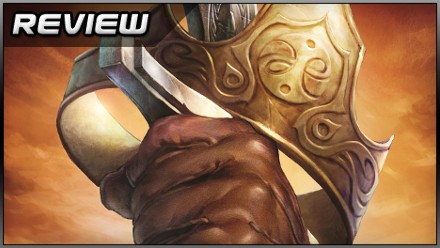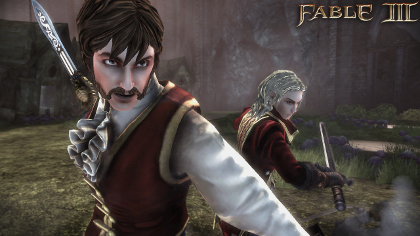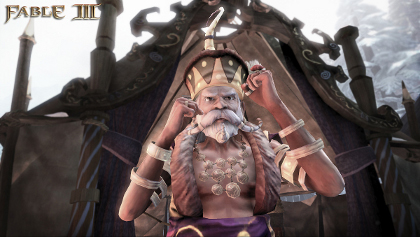
Fable III boasts around 30 hours’ worth of quests, main and peripheral, and those quests are so flavourless they could be foil-wrapped and served as airline food. Of the few that don’t amount to getting from village A via hand-wringing petitioner B to dungeon C, nine out of ten are glorified bouts of fetch (i.e. insert treasure chest, dig spot or floating glowy object D). The higgledy-pigglediness of the kingdom of Albion promises, at first glance, to put a few twists in the tale, but there’s that glittering “breadcrumb trail” waypoint system to smooth things out again, quietly and capably keeping your nose in the right direction.
Combat is where the crunch-factor lies, in theory. In practice, for all those gratifying slow-mo moneyshots, Fable III’s combat is a toothless lion. Restorative potions are plentiful, dodging is excessively effective, health recharges in seconds and most importantly of all, heroes never die. Get conked and the game will tuttingly deduct a thimbleful of experience points, pencil a scar across your character’s features and jolt you back to life a few feet from where you fell. Enemies do toughen up, but even if you single-mindedly bore through story missions at the expense of character growth, you’ll toughen up faster. I bit dust twice in my playthrough, and one of those tumbles came about because my lap was full of spaghetti.
Why, then, is wacky old Pete Molyneux’s latest tale of mystery, adventure and small animal molestation such enormously good fun? Why are its unlosable struggles so thrilling? What gives a mission portfolio that belongs in the hands of a pizza delivery boy the right to be so recklessly entertaining?
Well, one reason is that the writing is hilarious. Take the possessed garden gnomes I was hunting at three this morning, unleashed across the kingdom by a bumbling pottery fetishist. They differ from most open world collectables in having voices, not to mention a brilliantly awful sense of humour. “If you had me over for tea,” one rasps as I point a rifle at it, “I’d have yer mum.” Packed into the game’s reams of by-the-by chatter and cut-scene dialogue are laughs enough to give Spaced a run for its money, voiced by so many famous names it’s a wonder Microsoft has any budget left to blow on marketing. (Bernard ”Theoden” Hill gets our Oscar nomination – less for his jokes as for his gravitas, admittedly.)
Another reason, perhaps the more significant reason, is that Fable’s fantasy credentials are deceptive. The box art and promotional materials might scream “lore”, conjuring up intimidating visions of crafting menus, elemental binaries and D20s, but the franchise’s natural bedfellows aren’t, in fact, Dragon Age and Baldur’s Gate. When it forsakes the court of popular perception, Fable III does so in the company of Crackdown and Dead Rising – evolving sand-boxers rather than role-players in the traditional sense, whose charm lies less in difficulty or complexity as in seeing your actions and attitudes refracted through lots of beguiling little variables.
It’s all about fantasies of empowerment, in other words, about holding various mirrors up to the player and saying: “you know, old chum, you’re kind of a big deal”. And this strategy centres once again on your hero’s physical person, which alters depending on the choices you make as you explore the world’s 18 main regions and sparse litter of dungeons. Keep the unseen health gauge topped up with meat pasties, stay faithful to smitten NPCs and bestow stuffed toys on all the orphan children in the realm, and you’ll become a corpulent saint, rosy-cheeked and beaming. Nibble stalks of celery, have lots of one night stands and shoot every other stall-owner in the face, and you’ll wind up looking like Marilyn Manson.
The shifts are gradual and hard to eradicate, with no priests on show this time to reset your moral compass. An endgame hero is a sort of living, breathing autobiography, past decisions and tribulations etched into his or her physique, personality flaws traceable in crow’s feet or the arch of an eyebrow. While clearly past its sell by date, Lionhead’s engine is just about up to the task.
As a measure of player impact on character, the feature is infinitely more intuitive and compelling than any table of statistics – and appropriately enough, stats are very thin on the ground. Far thinner, in fact, than was the case even in the mightily stripped-back Fable II. Once upon a time, for instance, you had to pour experience points into an abstract Strength attribute to add muscle to your blows. Nowadays you just keep swinging till your character’s biceps get the message and, well, respond as I often wish mine would in real life.







 Satoru Iwata Video Interview - the late Nintendo president spoke with Kikizo in 2004 as 'Nintendo Revolution' loomed.
Satoru Iwata Video Interview - the late Nintendo president spoke with Kikizo in 2004 as 'Nintendo Revolution' loomed. Kaz Hirai Video Interview - the first of Kikizo's interviews with the man who went on to become global head of Sony.
Kaz Hirai Video Interview - the first of Kikizo's interviews with the man who went on to become global head of Sony. Ed Fries Video Interview - one of Xbox's founders discusses an epic journey from Excel to Xbox.
Ed Fries Video Interview - one of Xbox's founders discusses an epic journey from Excel to Xbox. Yu Suzuki, the Kikizo Interview - we spend time with one of gaming's most revered creators.
Yu Suzuki, the Kikizo Interview - we spend time with one of gaming's most revered creators. Tetris - The Making of an Icon: Alexey Pajitnov and Henk Rogers reveal the fascinating story behind Tetris
Tetris - The Making of an Icon: Alexey Pajitnov and Henk Rogers reveal the fascinating story behind Tetris Rare founders, Chris and Tim Stamper - their only interview? Genuinely 'rare' sit down with founders of the legendary studio.
Rare founders, Chris and Tim Stamper - their only interview? Genuinely 'rare' sit down with founders of the legendary studio. The History of First-Person Shooters - a retrospective, from Maze War to Modern Warfare
The History of First-Person Shooters - a retrospective, from Maze War to Modern Warfare